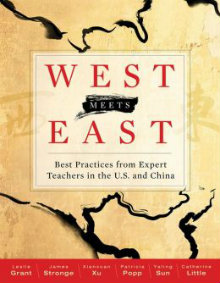West Meets East: Expert Teachers’ Best Practices
West Meets East: Best Practices from Expert Teachers in the U.S. and China
By Leslie Grant, James Stronge, Xianxuan Xu, Patricia Popp, Yaling Sun, and Catherine Little
(ASCD, 2014 – Learn more)

When I taught at universities in China in the 1990s, I always wondered what education at the primary and secondary level was like. I would see children coming and going from their school on the university campus where I taught in Wuhan, but I never had the opportunity to observe any classes in session. This book answers some of my questions.

Each country faces many obstacles to changing its educational system, and while the “best of both worlds” approach to teaching as outlined in West Meets East would be ideal, I fear it is unrealistic to believe it will happen any time soon. Still, we can learn.
An overview of the book
The first chapter, Introduction and Overview, explains how the Chinese and American teachers were selected for inclusion in the study and provides general background information about them while preserving their anonymity.
I would like to know more about each individual teacher; such as where he or she teaches, what grades and what subjects are taught, and how long the teacher has been teaching. This information could easily have been put in an appendix and would make it easier for readers to relate their own teaching experience to these educators.
This chapter also situates the study in the wider context of education reform in the U.S. and China, which is very helpful for American readers who are not familiar with the history of Chinese education.
Chapters 2, 3, 4, and 5 break down the teaching process into four categories: The Teacher, The Person; The Teacher, Instructional Planning and Assessment; Instructional Practice; and Classroom Organization, Management, and Discipline. Each chapter then compares and contrasts the American and Chinese teachers’ approaches to each of these areas of teaching.
There are sections called “Classroom Spotlights,” which offer vignettes from teachers’ classes; “Lessons” that attempt to draw conclusions based on the situation presented in the vignettes; reflections by American and Chinese teachers, in the form of quotations, on the particular ideas derived from the lessons; “Lessons from the East” and “Lessons from the West,” whose aim is to show readers how certain practices in each country can be transferred to the other country; and “Lesson Tools,” which are primarily a series of guiding questions related to the topic being discussed that readers can implement in their own classrooms. Each chapter has a varying number of these sections.
Organizational challenges
If it sounds confusing, that’s because it is! I found the organization of West Meets East to be its biggest drawback.
There are multiple “Lessons” in each chapter, but that subtitle is a misnomer because they aren’t descriptions of actual lessons that were taught by the teachers. Rather, they are descriptions of how the teachers utilized various methods and techniques in their teaching. And the “Lessons from the East” and “Lessons from the West” aren’t lessons per se but mostly additional descriptions of teaching practice, with the authors’ commentary about them.
The quotations are identified only by the country of the speaker, and I think it would be helpful to know at least what grade and subject the speaker teaches so readers can decide how relevant the comments are to their own teaching practice. Much reference is made to what happened in various classes and conclusions are drawn from these happenings, but readers are never told what the actual lessons consisted of aside from a few brief sentences that describe them.
All that said, it’s a fascinating comparison
But it was not too difficult to get beyond the confusing layout and focus on the similarities and differences between the Chinese and American teachers. And once I did that, I found West Meets East to be fascinating.
Chinese teachers have far more students in their classes than American teachers, but they also have much more planning time available to them during the week. Chinese teachers also collaborate on lesson planning far more than most American teachers do. How they go about designing lessons, deciding what to include and how to present material, was really quite interesting.
The book also shows how Chinese teachers’ attitudes toward their students differ from how American teachers regard their students. And methods of instructional delivery, while sharing some features, also differed in significant respects. Chinese and American teachers’ views on assessment were similar in some ways but different in others. Yet, West Meets East shows that all the teachers in the study achieved award-winning results with their students.
Throughout this 183-page book, charts and diagrams helped explain and expand on the points made by the authors. I thought that the last chapter, Lessons Learned, was the most useful because it summarized clearly all the conclusions made in the previous chapters. Figure 6.1 on Page 150, “Similarities and Differences Between U.S. and Chinese Teachers,” is especially helpful as it succinctly presents all the information gleaned in Chapters 2, 3, 4, and 5 in easy-to-read bullet points.
While this chapter alone makes West Meets East worth reading, the entire book contains ideas that teachers may want to try and implement in their own classrooms.
From a PISA perspective
It’s important to note that the authors believe “…students in the United States lag in academic performance when compared with their peers in other industrialized nations…” (P.2), citing results on the Program for International Student Assessment (PISA) to prove their contention. This perspective influences the favorable conclusions drawn from their observations of the Chinese teachers. Nowhere in this book are the Common Core State Standards mentioned, despite the fact that West Meets East was published in 2014.
Nevertheless, West Meets East offers readers many insights into the teaching practices of teachers recognized for their excellence and shows that educators in both the United States and China have much they can learn from each other.
Listen to a podcast about the book with co-author Leslie Grant or watch ASCD’s webinar with Grant and co-author James Stronge.
Susan Schwartz was an English as a Foreign Language (EFL) teacher and teacher trainer at universities in Wuhan and Nanjing, China, and in Banjarmasin, Indonesia, before spending 16 years at the Marsh Grammar School in Methuen, Massachusetts, where she most enjoyed teaching Social Studies to ELL middle schoolers. Susan traveled to India on a Fulbright-Hays Seminars Abroad program in 2007 and received an ING Unsung Heroes Award in 2010. From 1998-2007, she published Nexus: A Journal for Teachers in Development.


































